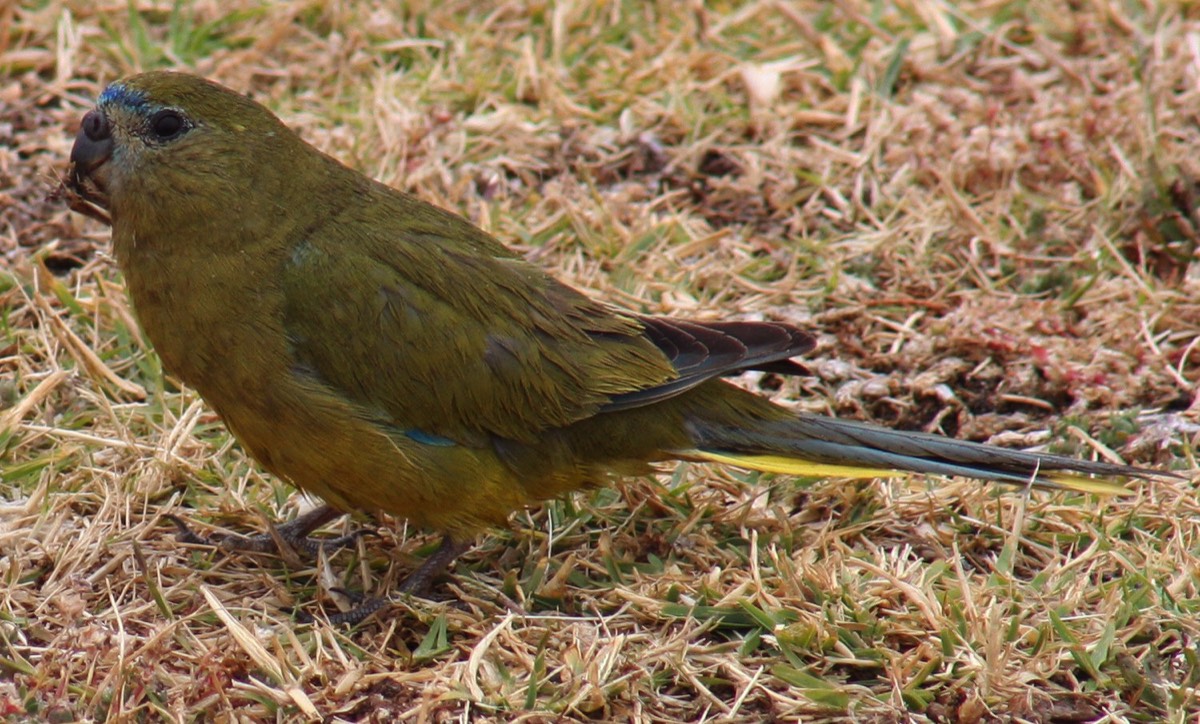Rock Parrot - Neophema Petrophila - Least Concern
The rock parrot (Neophema petrophila) is a species of grass parrot native to Australia. Described by John Gould in 1841, it is a small parrot 22 to 24 cm (8 3⁄4 to 9 1⁄2 in) long and weighing 50–60 g (1 3⁄4–2 oz) with predominantly olive-brown upperparts and more yellowish underparts. Its head is olive with light blue forecheeks and lores, and a dark blue frontal band line across the crown with lighter blue above and below. The sexes are similar in appearance, although the female tends to have a duller frontal band and less blue on the face. Two subspecies are recognised.
Rocky islands and coastal dune areas are the preferred habitats for this species, which is found from Lake Alexandrina in southeastern South Australia westwards across coastal South and Western Australia to Shark Bay. Unlike other grass parrots, it nests in burrows or rocky crevices mostly on offshore islands such as Rottnest Island. Seeds of grasses and succulent plants form the bulk of its diet. The species has suffered in the face of feral mammals; although its population is declining, it is considered to be a least-concern species by the International Union for Conservation of Nature (IUCN).
Two subspecies are recognised by the International Ornithologists' Union: subspecies petrophila from Western Australia and subspecies zietzi from South Australia,[8] the latter described by Gregory Mathews in 1912 from the Sir Joseph Banks Group in Spencer Gulf,[9] after the Assistant Director of the South Australian Museum Amandus Heinrich Christian Zietz.[10] The authors of the online edition of the Handbook of the Birds of the World do not regard this as distinct.
Description: Ranging from 22 to 24 cm (8 3⁄4 to 9 1⁄2 in) long with a 33–34 cm (13–13 1⁄2 in) wingspan, the rock parrot is a small and slightly built parrot weighing around 50–60 g (1 3⁄4–2 oz). The sexes are similar in appearance, with predominantly olive-brown upperparts including the head and neck, and more yellowish underparts. A dark blue band runs across the upper forehead between the eyes, bordered above by a thin light blue line that extends behind the eyes and below by a thicker light blue band across the lower forehead. The forecheeks and lores are light blue. In the adult female, the dark blue band is slightly duller and there is less blue on the face. The wings are predominantly olive, and display a two-toned blue leading edge when folded. The primary flight feathers are black with dark blue edges, while the inner wing feathers are olive. The tail is turquoise edged with yellow on its upper surface. The breast, flanks and abdomen are more olive-yellow, becoming more yellow towards the vent. The bases of the feathers on the head and body are grey, apart from those on the nape, which are white. These are not normally visible. The bill is black with pale highlights on both mandibles, the cere is black. The orbital eye-ring is grey and the iris is dark brown. The legs and feet are dark grey, with a pink tinge on the soles and rear of the tarsi.[13] Subspecies zietzi has paler and more yellowish plumage overall, though is of a similar size. Its plumage darkens with wear, and may be indistinguishable from the nominate subspecies when old.
Juveniles are a duller, darker olive all over and either lack or have indistinct blue frontal bands. Their primary flight feathers have yellow fringes. They have a yellowish or orange bill initially, which turns brown by ten weeks of age. Juvenile females have pale oval spots on their fourth to eighth primary flight feathers. They molt from juvenile to immature plumage when a few months old. Immature males and females closely resemble adults, though have worn-looking flight feathers. They then moult into adult plumage when they are twelve months old.
The rock parrot can be confused with the elegant parrot in Western Australia, or blue-winged parrot in South Australia, both of which have similar (though brighter) olive plumage. These two species also have yellow lores and the latter has much bluer wings. The orange-bellied parrot has brighter green plumage and green-yellow lores.
Distribution and Habitat: The rock parrot occurs along the coastline of southern Australia in two disjunct populations. In South Australia, it is found as far east as Lake Alexandrina and Goolwa, though is rare in the Fleurieu Peninsula. It was reported further east at Baudin Rocks near Robe, South Australia, in the 1930s, though not since. It is more common along the coastline of the northeastern Gulf St Vincent between Lefevre Peninsula and Port Wakefield, and Yorke Peninsula across Investigator Strait to Kangaroo Island, the Gambier Islands, and the Eyre Peninsula from Arno Bay to Ceduna and nearby Nuyts Archipelago. In Western Australia it is found from the Eyre Bird Observatory in the east, along the southern and western coastline to Jurien Bay Marine Park, becoming less common further north to Kalbarri and Shark Bay. Historically, it has been reported from Houtman Abrolhos.[17] The rock parrot is generally sedentary, though birds may disperse over 160 km (100 mi) after breeding. Some do remain on the offshore islands where they breed year-round.
The rock parrot is almost always encountered within a few hundred metres of the coast down to the high-water mark, though may occasionally follow estuaries a few kilometres inland. The preferred habitat is bare rocky ground or low coastal shrubland composed of plants such as pigface (Disphyma crassifolium clavellatum), saltbush (Atriplex) or nitre bush (Nitraria billardierei). The species has also been found in sand dunes and saltmarsh, and under sprinklers on the golf course on Rottnest Island. They tend to avoid farmland.

Psittaciformes, The Parrot Index, a part of Phoenix Feathers © 2016 - 2023
Page last updated: 12/24/23
Phoenix Feathers

